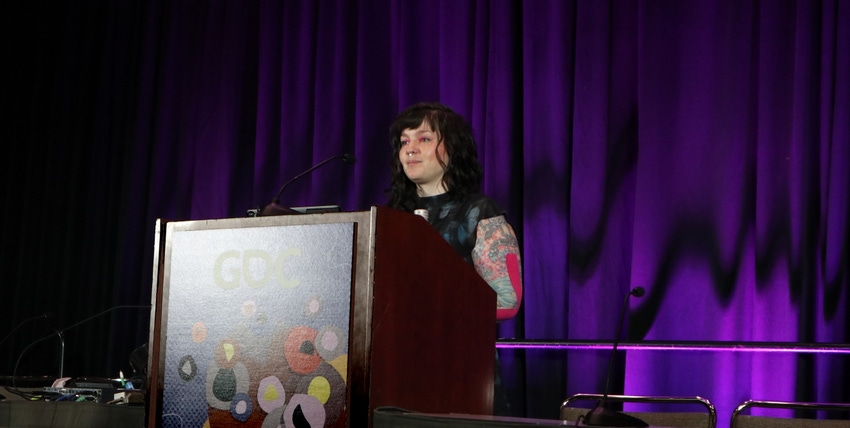.png?width=700&auto=webp&quality=80&disable=upscale)
Accessibility-specific menus in games may not be enough. At GDC 2023, Ubisoft shares real-world examples of why some current accessibility options fall short.

Accessibility is a key factor that game developers need to consider while working on their projects, but when should it become part of the conversation? At the 2023 Game Developers Conference, Ubisoft accessibility design lead and strategist Aderyn Thompson remarked on the number of event panels that revolve around video games that have already launched. In the accessibility field, they argued, that kind of delay can be catastrophic.
"Waiting to have an open dialogue about accessibility will be too late," they said. "We need to consciously work toward maturing the discipline."
The difference between accessibility and accommodations
As one of many GDC speakers focused on accessibility in video games, Thompson explored a disambiguation that they feel has been lacking across the industry. Current solutions, particularly in-game "accessibility" menus, are in Thompson's view often better described as accommodations: "a concession or assistance when there isn't equitable access," used in games "when existing systems are least malleable."
To drive this point home, Thompson presented two examples of wheelchair-friendly access to a real-world building, pictured above. The first included a ramp seamlessly attached to a business's front door; the second showed a crowded, snow-lined alleyway past a trash bin, which leads to a back door that requires ringing a bell to get special assistance.
"Accessibility," Thompson said as a point of differentiation, "is participation on par with everyone else. It's not a separate experience: no inconvenience, embarrassment, or pity, and it doesn't make someone stand out."
When a video game's core systems and mechanics don't take accessibility into account, Thompson argued, an affected player's experience can be similar. As one example, Thompson cited internal Ubisoft research that suggested a stigma attached to options placed in an accessibility-tagged menu, thus making them less attractive on a whole.
They suggested that developers may better serve players by placing options in relevant submenus, whether they arose thanks to accessibility concerns or not. One hidden benefit of doing so, Thompson argued, is that more players may discover and toggle options that impact undiagnosed disabilities.
A fox, a bird, and a gust of wind
Thompson was careful not to call out specific negative examples of inequitable accessible design, and that itself was by design. "A game is a set of intentional, well-crafted barriers," they said. "Across a variety of genres, standardizing games is a minefield, and we need to be honest: we're still figuring it out. If we don't admit that, things can get locked in too soon."
Thompson's team at Ubisoft isn't just genre-agnostic in its approach. "In design, everything overlaps," they said. "There is no such thing as 'blind accessibility,' 'deaf accessibility,' etcetera. Yes, that is what I said. We try not to work toward making features for specific players; it is just accessibility. No disability type exists in a silo, and many players have multiple disabilities."
At Ubisoft, Thompson and their fellow accessibility team members begin their work during any game's pre-production period by inviting each design team to a three-hour, participation-filled seminar. This includes a look at games with more holistic takes on accessible game design, and Thompson's first example is the waypoint guidance variety found in Sucker Punch Productions' Ghost of Tsushima: "follow the wind, the bird, and the fox" inside the game world instead of glaring, obvious arrows to a quest or objective.
These three unique indicators come with their own variety of audio, visual, and haptic signals, and they align with Thompson's belief that "game design is also UX, and that's the key to making games accessible." They admit that these systems could have included even more communication to players, particularly finely tuned haptic feedback or visual indicators of audio cues.
Seminar participants examine both existing video games and their own in-development project, all while Thompson and their team explain historically significant hindrances that various players with disabilities may face in video games. The designers are then encouraged to "reverse-brainstorm" the games they've just watched or played to "identify unintentional player barriers." Once a small list of barriers is generated, Thompson focuses on a single agreed-upon barrier and asks the participating devs to try and reverse the barrier—and understand how and why a game's intentions for players' interactions aren't manifesting. "We choose one [barrier] to focus on because we're not trying to solve accessibility," Thompson said. "We're teaching a new mindset."
"Solve the barrier, unify all players' experience"
Adjusting designers' mindsets at a base, pre-production level has an intended side effect of changing an unproductive default in the industry. "In accessibility, we hear a lot of direct feature requests from players and even other developers telling us what we need to have in our games," Thompson said. "We need to ask ourselves: are they right?"
Many other disciplines in game design agree that players aren't designers, so while feedback is crucial, and disabled players are experts in their experiences, developers will be more productive asking questions like: what is the barrier that a player is encountering? What is the root cause of a complaint? What is it like to live day-by-day with a specific disability? With an answer to those questions in mind, Thompson said, "only then can we solve the barrier and unify all players' experience" in a game.
Thompson pointed to examples in recent Ubisoft games that were borne from pre-production examinations. The 2021 refresh of the real-guitar rhythm game Rocksmith includes a "riff repeater" option that slows down parts of songs to help players of all expertise players focus on a tricky portion. ("It's not about making the guitar itself accessible," Thompson argued.) The Just Dance series has continued adding dance routines that are seated-friendly, with a few including silhouette dancers in wheelchairs. Various icons found in Mario + Rabbids: Sparks of Hope were tuned to be visible with any color settings enabled—which isn't just a colorblindness consideration, but also benefits low-vision and cognitive access, and even lets migraine sufferers turn color saturation down.
Thompson then turned their attention to high-challenge games and genres, specifically calling out roguelikes, Souls-likes and Metroidvanias. They acknowledged that an accessibility-minded guide to those genres would require its own hour-long presentation but concluded the panel with optimism about how they could be handled as the industry moves forward.
"These [genres] are not incompatible with accessibility," Thompson said. "Why? Because we make the rules. Disabled players want challenge and mastery. Easy modes can feel patronizing. It's up to us to define challenge and mastery. Almost every aspect of a game can be challenging for disabled players. So let's understand how players have limited interaction and account for them."
This article has been updated to correct language use surrounding disabilities.
Read more about:
FeaturesAbout the Author(s)
You May Also Like









